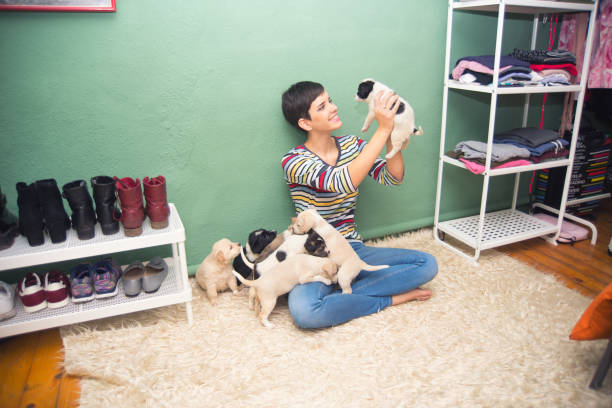Effective Pet Training
Pet Training Essentials Every Owner Should Know and Use
Introduction: The Foundation of Effective Pet Training
Training is a fundamental aspect of responsible pet ownership, ensuring your pet develops good behavior, follows commands, and integrates well into your home and daily life. Whether you’re a first-time pet owner or a seasoned one, understanding and implementing key training essentials can make a significant difference in your pet’s behavior and your relationship with them. This article outlines essential training principles and techniques that every pet owner should know and use to foster a well-behaved and happy companion.
1. The Principles of Effective Training
1.1. Positive Reinforcement
- Reward-Based Learning: Positive reinforcement involves rewarding your pet for desired behaviors with treats, praise, or toys. This encourages them to repeat those behaviors.
- Consistency: Be consistent with commands and rewards. Ensure that all family members use the same cues and reward systems to avoid confusion.
1.2. Clear Communication
- Command Clarity: Use clear, simple commands and signals. Avoid using multiple words for the same command to prevent misunderstandings.
- Body Language: Combine verbal commands with consistent body language to reinforce your messages. For example, a hand signal can accompany a command like “sit.”
1.3. Patience and Persistence
- Gradual Learning: Understand that learning takes time. Be patient and persistent, especially when teaching new commands or addressing behavioral issues.
- Short Sessions: Conduct short, frequent training sessions to keep your pet engaged and prevent frustration. Aim for 5-10 minutes per session.
2. Fundamental Training Techniques
2.1. Basic Commands
- “Sit”: Hold a treat above your pet’s nose and move it slowly towards their tail. As their head follows the treat, their bottom will lower. Reward them once they are in the sitting position.
- “Stay”: Ask your pet to sit, then use an open hand with the “stay” command while gradually stepping back. Reward them for staying in place.
2.2. Leash Training
- Loose Leash Walking: Teach your pet to walk calmly on a leash without pulling. Reward them for walking beside you and use treats to reinforce this behavior.
- Recall Training: Practice recall commands by calling your pet to come to you from a short distance. Gradually increase the distance as they become more reliable.
3. Addressing Behavioral Issues
3.1. Barking and Whining
- Understanding Triggers: Identify what triggers excessive barking or whining, such as boredom or anxiety. Address the underlying cause rather than just the behavior.
- Redirection: Use redirection techniques by providing your pet with engaging toys or activities to divert their attention from the behavior.
3.2. Chewing and Destructive Behavior
- Proper Chew Toys: Provide appropriate chew toys and discourage chewing on furniture or personal items by redirecting their attention.
- Exercise and Stimulation: Ensure your pet gets sufficient physical exercise and mental stimulation to reduce boredom-related destructive behaviors.
4. Advanced Training Techniques
4.1. Clicker Training
- Introducing the Clicker: Use a clicker to mark desired behaviors with a distinct sound, followed by a reward. This helps your pet associate the click with positive reinforcement.
- Shaping Behavior: Break down complex behaviors into smaller steps and use the clicker to reward each step, gradually building up to the final behavior.
4.2. Socialization
- Exposure to New Experiences: Gradually expose your pet to new people, animals, and environments to enhance their social skills and reduce fear or aggression.
- Positive Encounters: Ensure that new experiences are positive and rewarding, helping your pet develop confidence and adaptability.
5. Tools and Resources
5.1. Training Aids
- Leashes and Harnesses: Use appropriate leashes and harnesses for training. A well-fitting harness can provide better control and comfort for both you and your pet.
- Training Treats: Select high-value treats that are small and easy to handle. Treats should be tasty enough to motivate your pet without causing overfeeding.
5.2. Professional Help
- Certified Trainers: Seek assistance from certified professional trainers if you encounter difficulties or need specialized guidance. Look for trainers who use positive reinforcement methods.
- Training Classes: Enroll in group training classes for socialization opportunities and to learn new skills in a supportive environment.
6. Building a Strong Bond Through Training
6.1. Positive Interaction
- Engagement: Regularly engage with your pet through play, training, and positive reinforcement to strengthen your bond and build trust.
- Affection and Praise: Show affection and provide verbal praise during and after training sessions to encourage a positive learning experience.
6.2. Consistency at Home
- Reinforcing Training: Incorporate training commands and behaviors into your daily routine to reinforce what your pet has learned. Consistency at home helps solidify their training.
- Family Involvement: Ensure that all family members are involved in the training process and use consistent commands and rewards.
Conclusion: The Journey of Training and Growth
Effective pet training is a continuous journey that enhances your pet’s behavior and strengthens your relationship. By understanding and applying essential training principles, employing fundamental and advanced techniques, and utilizing the right tools and resources, you can create a well-behaved, happy, and confident companion. Remember, training requires patience, persistence, and positive reinforcement. With dedication and the right approach, you can achieve a harmonious and fulfilling relationship with your beloved pet.

